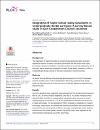Integration of haptic virtual reality simulators in undergraduate dental curricula: A survey-based study in Gulf Cooperation Council countries
| Author | Matoug-Elwerfelli, Manal |
| Author | Al-Khabuli, Jumma O. |
| Author | Alhobeira, Hazza A. |
| Author | Dass, Hanin |
| Author | Abdou, Ahmed M.A. |
| Author | Ali, Kamran |
| Available date | 2025-09-29T10:40:17Z |
| Publication Date | 2025 |
| Publication Name | PLOS ONE |
| Resource | Scopus |
| Identifier | http://dx.doi.org/10.1371/journal.pone.0322810 |
| ISSN | 19326203 |
| Abstract | Background The integration of haptic simulators in contemporary dental education has been reported to improve students' hand-eye coordination and fine motor skills during pre-clinical education to facilitate a smooth transition to the clinical setting. The aim of this study was to assess the integration of haptic virtual reality simulation (HVRS) in undergraduate dental curricula in the Gulf Cooperation Council countries. Methods All dental schools offering undergraduate dental programs in the Gulf Cooperation Council countries were invited to participate in this cross-sectional study design. Data was collected using an online survey on a voluntary basis and analyzed using Microsoft Excel. Results Out of 34 dental schools, responses were received from 30 dental schools (response rate 88.2%). In terms of haptic integration, only two (6.7%) dental institutions have adopted haptic simulation in undergraduate dental education. However, a considerable proportion of schools (n = 13, 46.4%) expressed an interest in the future use of haptic technology. The key strengths of HRVS included the integration of modern technology, opportunities for self-directed learning, development and consolidation of manual skills, and boosting self-confidence amongst undergraduate dental students. Financial cost and limited patient cases in the HRVS library were regarded as the main barriers to widespread use of this technology. Conclusion Although the Gulf Cooperation Council countries have strong economies with a high gross domestic product (GDP), only a limited number of dental schools have incorporated haptic technology in their curricula. Nevertheless, a high proportion of dental schools in the region are actively considering purchasing and implementation of haptic devices in undergraduate dental programs. |
| Language | en |
| Publisher | Public Library of Science |
| Subject | Adult Article Cross-sectional Study Dental Education Female Gross National Product Human Human Experiment Male Normal Human Open Access Publishing Questionnaire Self-directed Learning Training Undergraduate Education Curriculum Dental Student Procedures Virtual Reality Cross-sectional Studies Curriculum Education, Dental Humans Students, Dental Surveys And Questionnaires Virtual Reality |
| Type | Article |
| Issue Number | 5-May |
| Volume Number | 20 |
Files in this item
This item appears in the following Collection(s)
-
Dental Medicine Research [436 items ]


